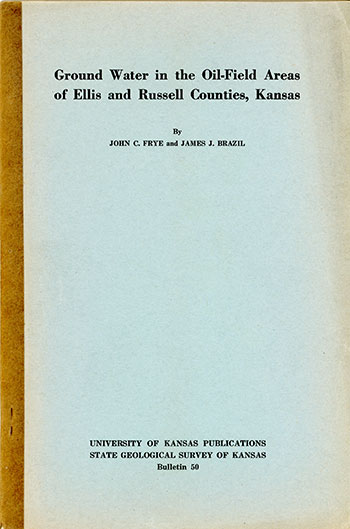Ground Water in the Oil-field Areas of Ellis and Russell Counties, Kansas
By John C. Frye and James J. Brazil
with analyses by Howard Stoltenberg
Prepared by the United States Geological Survey, the State Geological Survey of Kansas, and the Division of Sanitation of the Kansas State Board of Health, with the cooperation of the Division of Water Resources of the Kansas State Board of Agriculture

Originally published in 1943 as Kansas Geological Survey Bulletin 50. This is, in general, the original text as published. The information has not been updated. An Acrobat PDF version (11 MB) is also available; plate available separately.
Abstract
The oil-field areas described are located in western, central, and southern Russell County, and east-central and northeastern Ellis County. This area is a part of the Plains Border section of the Great Plains physiographic province. The area is well dissected and is drained by Smoky Hill and Saline rivers and their tributaries.
The stratified rocks of this area consist of deposits of Cretaceous, Tertiary, Pleistocene, and Recent age, and include the Dakota formation, Graneros shale, Greenhorn limestone, Carlile shale, and Niobrara formation of Cretaceous age; the Ogallala formation (?) of Tertiary age; Pleistocene terrace deposits of sand, gravel, silt, and volcanic ash; and Recent alluvium. Although not exposed in this area, the Kiowa shale, Cheyenne sandstone, and Permian redbeds were encountered in test holes. The quality of the water contained in these formations ranges within wide limits. Water in the Cheyenne sandstone probably is highly mineralized everywhere in this area. Water in some of the sandstones of the Dakota formation is also mineralized; however, many wells obtain potable water from sandstone beds in the Dakota formation. Waters contained in rocks younger than the Dakota formation are generally of a quality satisfactory for most uses, except in some places where they have been polluted by brines from deeper formations.
The depth to water level in wells ranges from about 5 feet in wells along the valley flats of the major streams to more than 150 feet in some upland wells tapping sandstones in the Dakota formation.
The ground-water reservoir is recharged by downward percolation of rainfall in the area, and by lateral migration of water through the rocks from areas to the west.
The physical properties of sandstones of the Dakota formation and sand and gravel of the Tertiary, Pleistocene, and Recent deposits are summarized. These water-bearing materials range from coarse gravel to very fine sand and sandstone, and have coefficients of permeability ranging from less than 1 to as much as 50,000. Generally the sandstones of the Dakota formation are much finer and have lower coefficients of permeability than the sand and gravel of Tertiary, Quaternary, and Recent age.
Kansas Geological Survey, Geology
Placed on web Jan. 26, 2017; originally published December 1944.
Comments to webadmin@kgs.ku.edu
The URL for this page is http://www.kgs.ku.edu/Publications/Bulletins/50/index.html